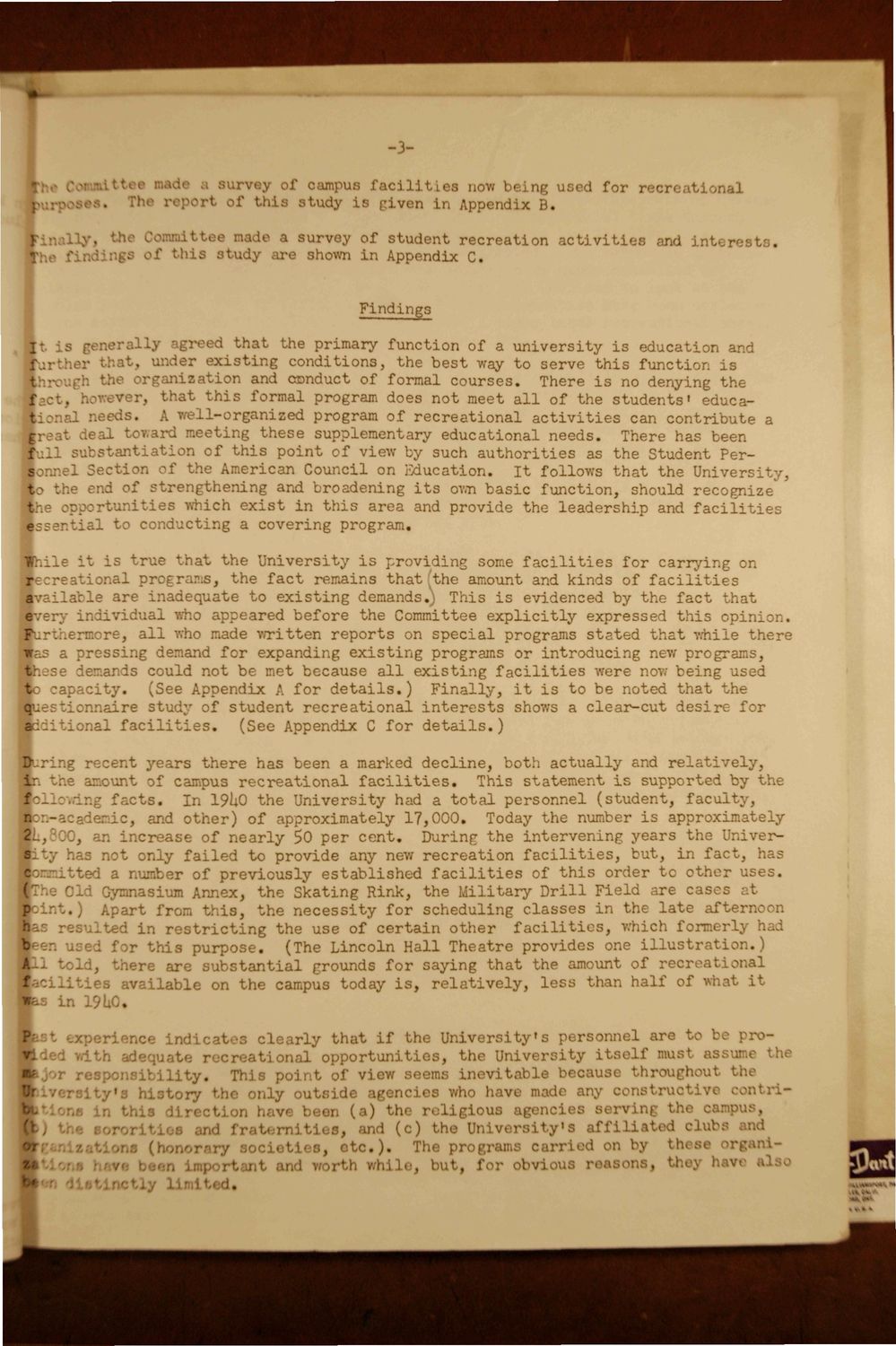| |
| |
Caption: Book - Report on Need for Campus Recreation Facilities (1947)
This is a reduced-resolution page image for fast online browsing.

EXTRACTED TEXT FROM PAGE:
I >s% ~~ ta ( 7 of campus facilit B now being u: i for recreate The report of this study is given in Appendix B. L Lly, the I ttot le a survey of student recreation activities i . interest . >f this study are shown in Appendix C. Findin 3 j: lerally agreed that the primary function of a university is education and f •-. U ier existing conditions, the best way to serve this function is •hn the organization and conduct of formal courses. There is no denying the WQH ver, that this formal program does not meet all of the students' educa•: eeds. A well-organized program of recreational activities can contribute a h i i d tc ird meeting these supplementary educational needs. There has been t f ill substantiation of this point of view by such authorities as the Student Perllonnel Section of the American Council on Education. It follows that the University, to '.he end of strengthening and broadening its own basic function, should recognize the c ortunities which exist in this area and provide the leadership and facilities e tial to conducting a covering program. Lie it is true that the University is providing some facilities for carrying on •ecreational pr rams, the fact remains that ^the amount and kinds of facilities a liable are inadequate to existing demands.) This is evidenced by the fact that every individual who appeared before the Committee explicitly expressed this opinion. Flirt ermore, all who made written reports on special programs stated that while there w a pressing demand for expanding existing programs or introducing new programs, t se demands could not be met because all existing facilities were now being used iltc capacity. (See Appendix A for details.) Finally, it is to be noted that the q tioi aire study of student recreational interests shows a clear-cut desire for additional facilities. (See Appendix C for details.) D" r g recent years there has been a marked decline, both actually and relatively, lir the amount of campus recreational facilities. This statement is supported by the fol • facte. In 19U0 the University had a total personnel (student, faculty, •o:iemic, and other) of approximately 17,000. Today the number is approxi -tely 2L, , ncrease of nearly 50 per cent. During the intervening years the UniverIs. '3 not only failed to provide any new recreation facilities, but, in fact, has ted a number of previously established facilities of this order tc other uses. k e ( 1 Gymnas m Annex, the Skating Rink, the Military Drill Field are cases at ? at.) Apart from this, the necessity for scheduling classes in the late afterr. n h : in restricting the use of certain other facilities, which formerly had r this purpose. (The Lincoln Hall Theatre provides one illustration.) • 1 1 told, there are substantial grounds for saying that the amount of recreati al P s available on the campus today is, relatively, less than half of what it •as in 19hC. P ri ce ind at clearly that if the University's personnel are to be o•.:ed with adequate r croational opportunities, the University it If must assuhe V : sponsibility. T • ^ of view s< :ns inevitable because through t t Ur 3i > history th . .ly outside Les who have ma any c ti Hi in this -ect : v -on ( the religious agencies serving the '• and at dtj *, and (c) the University's ftff iated ub:' s ( soci( s, etc.). The programs carr d on by these 74 ' * re bee.. istinc lin rtsnt and bh while, but, for obvious reaso , they have also
| |